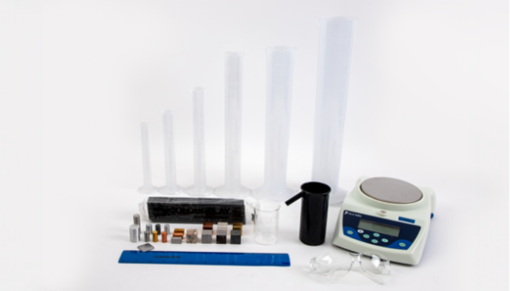
Density GCSE Physics Practical Experiment
Investigating the density of regular and irregular shaped solids and liquids using a range of appropriate apparatus.
During this practical, students will investigate the density of various objects and a solution. They are assessed on their ability to accurately determine the density of regular and irregularly shaped objects. They will then use the displacement method to confirm the density of the objects and will also determine the density of sucrose solution. Their ability to take accurate measurements in length, mass and volume and how they use these to determine density is also observed. The standard units of density are kg/m³ so some calculation is required to convert the units.
| Subject: Physics | Level: GCSE |
Method
Activity 1: Determine the density of a regularly shaped object.
- Students should select a regularly shaped object, such as the density cubes or density blocks. They are going to measure the length, width and height of the object, using a ruler, and use these measurements to calculate the volume of the object.
- These results are recorded in a suitable table.
- Using an electronic balance, students should measure the mass of the object and note this in their table in grams.
- They can then calculate the density in g/cm³ of the object by dividing the mass by its volume.
- Students should then convert their measurements into kg and m³ and again calculate the density, this time in kg/m³.
Activity 2: Determine the density of an irregularly shaped object.
- Using an electronic balance, students should measure the mass of the irregularly shaped object they have chosen and note this value in their table.
- The displacement can is then filled up with water so that the water level is just above the spout, taking care to catch any excess water in an empty beaker which is held under the spout of the displacement can.
- Once the liquid has stopped dripping from the spout, students then replace the beaker with an appropriate measuring cylinder. The size of the measuring cylinder should be chosen by the students to reflect what sized cylinder they think will give them the most accurate reading.
- They must now carefully add one of the irregular shape objects to the displacement can, holding it under the water level using a paperclip or cocktail stick if it is a floating object, and wait for the water to stop dripping from the displacement can into the measuring cylinder.
- They should record the volume of water which has been displaced by the object and is collected in the measuring cylinder accurately. This is done by viewing the meniscus of the liquid. This volume of water is equal to the volume of the object they have chosen. Students can now calculate the density of the object by dividing its mass by the volume of water.
- The procedure is then repeated for other irregular objects, students must remember to re-fill the displacement can with water each time and ensure they are giving density values in kg/m³.
Activity 3: Determine the density of a liquid.
- Students should weigh an empty 100ml measuring cylinder on an electronic balance and record their results in a suitable table.
- Approximately 100mls of sugar solution is then added to the measuring cylinder and the volume is recorded accurately by viewing the meniscus of the liquid.
- Students must now re-weigh the measuring cylinder, and using this mass, they can calculate the density of the liquid by dividing the mass by the volume, making sure they are calculating the densities in kg/m³.

Technician tips
- The sucrose solution can be prepared in advance. The students do not need to know its concentration for this experiment.
- To make a 1M solution of sucrose, 342.3g of the solid are dissolved in 1000mls of water.
- Irregularly shaped objects could be different sized and shaped pieces of polystyrene or plasticine which have been prepared before the lesson.










